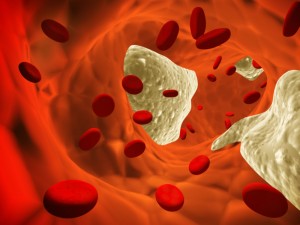Peripheral Artery Disease
 Peripheral artery disease (PAD) is often caused by atherosclerosis, an accumulation of plaque in the peripheral arteries, which carry blood to the arms, legs and internal organs. Atherosclerosis causes the peripheral arteries to narrow and harden, and/or become blocked. By reducing the amount of blood that flows to the limbs and organs, atherosclerosis increases the risk of heart attack, stroke and transient ischemic attack. It can also cause limbs to become infected and, in severe cases, gangrenous.
Peripheral artery disease (PAD) is often caused by atherosclerosis, an accumulation of plaque in the peripheral arteries, which carry blood to the arms, legs and internal organs. Atherosclerosis causes the peripheral arteries to narrow and harden, and/or become blocked. By reducing the amount of blood that flows to the limbs and organs, atherosclerosis increases the risk of heart attack, stroke and transient ischemic attack. It can also cause limbs to become infected and, in severe cases, gangrenous.
Symptoms of Peripheral Artery Disease
Many people with peripheral artery disease do not display symptoms. For those that do, symptoms may include the following:
- Leg pain that occurs during exercise and ceases during rest
- Numbness, coldness, change of color or loss of hair in the legs or feet
- Cramps in the legs or hips
- Paleness or blueness, or weak or absent pulse, in a limb
- Change in gait
- Sores on the legs, feet or toes that do not heal
Diagnosis of Peripheral Artery Disease
Often, a physical exam provides the first indication of peripheral artery disease. There are also a number of tests used to detect its presence. They include the following:
- Ankle-brachial index (ABI)
- Doppler ultrasound
- Angiogram
- Magnetic resonance imaging (MRI) arteriogram
- Plethysmogram
- Venogram
If PAD is severe, the patient is often referred by a primary care physician to a vascular specialist or cardiologist.
Treatment for Peripheral Artery Disease
There are several treatments for peripheral artery disease, and the majority of them involve lifestyle changes. Treatment includes the following:
- Supervised exercise routine
- Modifications to diet
- Stopping smoking
- Lowering blood sugar (if diabetic)
- Managing high blood pressure
Medication
If lifestyle changes and medication are not effective, one of the following may be recommended.
Angioplasty and Stenting
During angioplasty, a catheter with a balloon on its end is inserted into the blocked artery, and gently expanded, pushing open the blockage and restoring blood flow to the area. The catheter is then removed. A stent, which is a tiny metal cylinder, is sometimes placed in the artery to ensure that it remains open.
Cryoplasty
Cryoplasty, also known as cryoballoon angioplasty, is a nonsurgical technique that combines cold therapy with angioplasty. During cryoplasty, nitrous oxide is delivered to the blocked artery to freeze the plaque. The frozen plaque breaks up, and is then removed from the artery. Cryoplasty minimizes the growth of scar tissue, which may reduce the possibility of future blockages.
Atherectomy
Atherectomy is a procedure to remove plaque from the artery walls with a sharp blade that has been attached to the end of a catheter. The catheter then collects the plaque that has been shaved or cut off. Atherectomy is used in blood vessels that cannot be stented or that have branches. In some cases, a laser is used to remove plaque.
Bypass Grafting
Bypass grafting restores circulation by grafting (connecting) a blood vessel to a blocked artery, and then rerouting blood flow around it. Grafting uses either a healthy blood vessel from another part of the body or a device made of synthetic material.
Although PAD affects people of all ages, it is most common in those older than 50.
